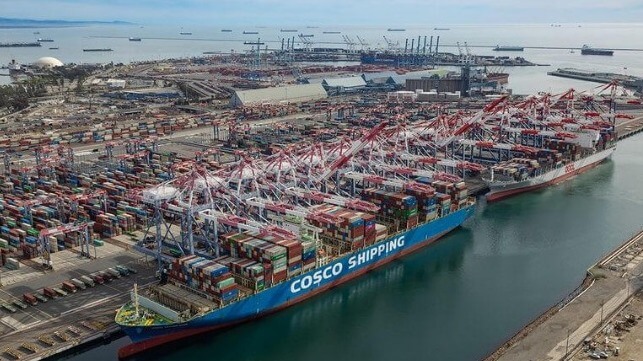Slow Start to 2023 Volumes in Long Beach Due to Economy and Labor

Container volume at the Port of Long Beach is off to a slow start in 2023 as port officials continue to blame softened consumer spending, increased prices driven by inflation, and changes in trade routes. Adding to the frustrations are the continued delay in completing a new labor contract for the longshore workers which may be continuing to spur shippers to divert volume to alternate ports.
The Port of Long Beach released its January 2023 data on port volumes and it was the third month in a row where the port handled less than 600,000 TEU in a month. The port had been above that level for 30 consecutive months from May 2020 through October 2022, averaging 775,000 TEU during those months and peaking at over 900,000 TEU in May 2021. Volumes peaked in May 2022 and began a steady monthly decline as of August 2022.
Dockworkers and terminal operators moved 573,772 TEUs in January 2023, which while up five percent from December 2022 was down 28.4 percent from January 2022. Imports lead the year-over-decline coming in nearly a third below the year-ago level. Exports also declined more than 14 percent but not as quickly as the import volumes fell. It however also marks a decline from December 2022 when exports were up nearly two percent year over year.
“We are taking aggressive steps to meet a new set of challenges for the new year,” said Port of Long Beach Executive Director Mario Cordero. “I remain optimistic that we will recapture market share and develop projects that will enhance our long-term growth, sustainable operations, and the reliable movement of goods through the Port of Long Beach.”
While the port focused on economic issues in its monthly report, everyone remains frustrated by the lack of an agreement between the union and terminal operators 10 months after the contract expired. There have not been any disrupts to traffic at the West Coast ports, but fears remain high with the U.S. Secretary of Labor Marty Walsh telling Bloomberg last week that they thought a deal would have been reached by now. Everyone expects that volumes would start 2023 low, with retailers for example saying they expected volumes to be down for the first half of the year, but shippers also remain fearful the longer the labor negotiations drag on with ports along the East Coast and Gulf of Mexico reporting benefits and softer declines versus the West Coast.
“We’re confident we will grow cargo volume by working with our industry stakeholders,” said Long Beach Harbor Commission President Sharon L. Weissman. “We are focused on investing in infrastructure projects that will improve air quality and make us more competitive.”
The Port of Los Angeles has expressed a similar frustration as it experiences volume declines while it waits for the labor agreement. While working to build cargo volumes in part by highlighting the clearance of the long backlogs, Los Angeles like neighboring Long Beach is also focusing on infrastructure and taking a long-term view. At its upcoming monthly update, Los Angeles will focus on its efforts to enhance its position in the cruise industry and its recently released plan for a major expansion and overhaul of the cruise facilities.
